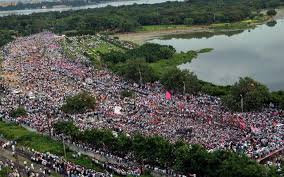Q. Unequal distribution of benefits of development on regional basis eventually promotes regionalism. Substantiate your answer with illustration.
Ans: Unequal distribution of benefits of development on a regional basis can indeed lead to the rise of regionalism, where certain regions within a country demand greater autonomy or resources due to perceived neglect or disparities. This phenomenon is often fueled by economic, social, and political factors. An illustration of this can be seen in the case of the Telangana movement.

Illustration: Telangana Movement in India
The Telangana movement, which gained momentum in the early 21st century, exemplifies how unequal distribution of development benefits can lead to regionalism:
Background: Telangana is a region in the southern Indian state of Andhra Pradesh. Historically, the region had been subject to neglect in terms of economic development, education, and political representation. People in Telangana felt that they were not receiving a fair share of the benefits of progress and were facing disparities compared to the rest of the state.
Unequal Development: The coastal Andhra region of Andhra Pradesh, which includes the city of Hyderabad, had witnessed rapid economic growth and development, driven by factors like information technology, industrialization, and urbanization. However, much of this development was concentrated in this region, while Telangana lagged behind in various development indicators.
Perceived Neglect: The people of Telangana felt that their region was being neglected in terms of infrastructure, education, healthcare, and job opportunities. They believed that the benefits of development were disproportionately favoring the more prosperous coastal Andhra region.
Demand for Separate Statehood: The unequal distribution of development benefits, along with cultural and historical differences, led to the demand for a separate state of Telangana. Proponents of the movement argued that having a separate state would allow them to have more control over their resources and development policies.
Political Mobilization: The movement gained traction through mass protests, strikes, and political mobilization. Public sentiment and grievances against unequal development contributed to the growth of regionalism and demands for a separate Telangana state.
Government Response: The Indian government eventually responded to the movement by agreeing to the demand for a separate Telangana state. Telangana was carved out as India’s 29th state in 2014.
Impact: The Telangana movement highlighted how regional disparities in development can fuel regionalism and demands for greater autonomy. The creation of the new state aimed to address the perceived neglect and provide a platform for more region-specific development policies.
This illustration underscores the fact that when development benefits are unequally distributed among different regions within a country, it can lead to feelings of marginalization, fueling regionalism and demands for greater self-governance or autonomy. To prevent or address such situations, it is important for governments to ensure equitable development and allocate resources fairly across regions, fostering a sense of unity and shared progress.
Thanks for reading the answer to the question: Unequal distribution of benefits of development on regional basis eventually promotes regionalism. Substantiate your answer with illustration.